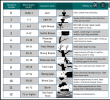I think you are asking how does a company come assign a Beaufort Scale number? I think it's largely subjective. Obviously for a company wanting to sell a product, if there are shades of gray they're going to make it look as good as they can on paper. Below is a shot of the Beaufort Scale and if the SE can fly at 29mph in sport mode the SE technically falls into the Scale 5 category. But then using this standard the
Mini 2 with a top speed of 36mph could be assigned a scale 6 or 7. But that's not realistic.
The
Mavic 2 Pro with a max speed of 45mph (72kph) does not have an official Beaufort rating on the DJI spec sheet, but some peg it at Scale 5. DJI does stated the max wind resistance as copied/pasted below.
It seems highly unrealistic for the two drones, one that can fly 90% faster than the other with much more power to have the same Beaufort Scale rating. The other thing to consider is gusts and out inability to judge the intermittence or consistent force of any gust. As an example, right now I'm looking at UAV Forecast and wind is at 12mph but gusts double that at 24mph. Seems fine for a
Mini 2 or SE based on Beaufort. But at 250 feet the wind is noted at 18mph and 28mph gusts. Bottom line, for me personally in the current wind conditions I'd be ok flying my
Mavic 2 Pro (which is largely why I bought it), *might* take a chance on the
Mini 2... but my
Mini 1/SE would be grounded. JMO
| MAVIC 2 Max Wind Speed Resistance | 18mph-24mph/29–38 kph |
|---|
View attachment 143169











